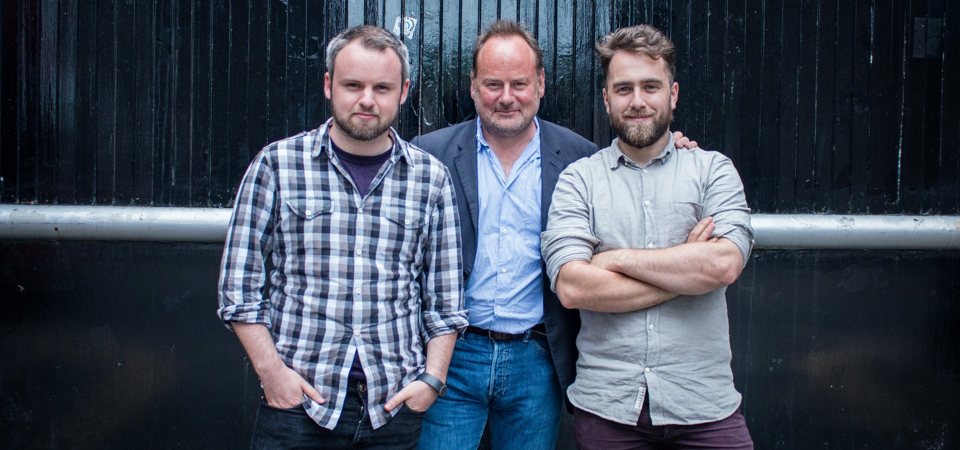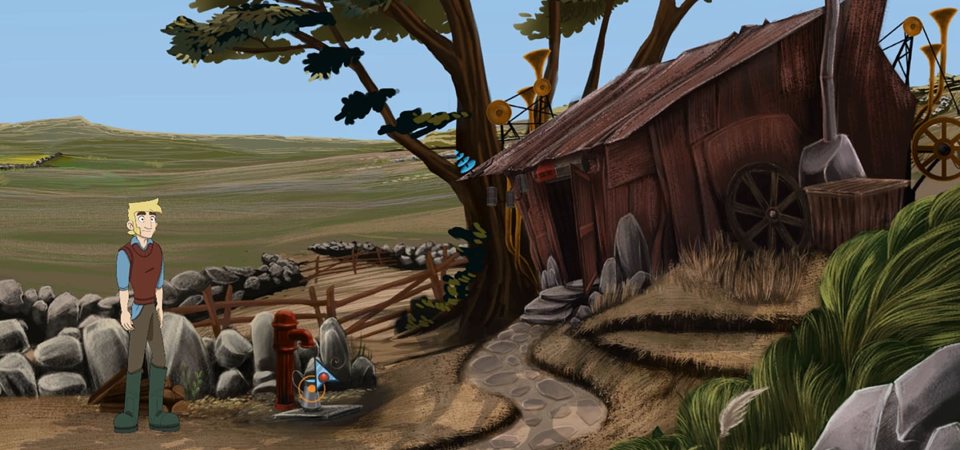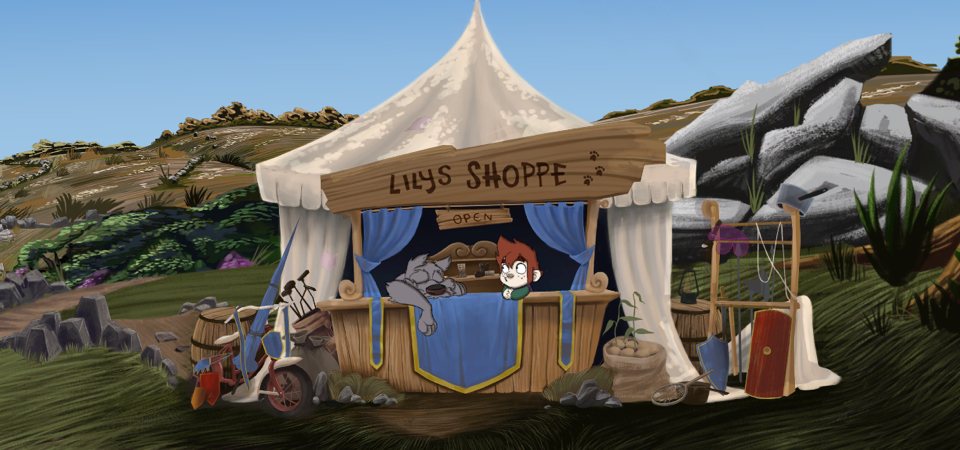The adventure game genre has really blossomed over the last half decade, branching out in lots of different ways, but there’s always a certain fondness for the genre’s classics, whether it’s the Monkey Island series or Broken Sword. So when you see Broken Sword’s creator, Charles Cecil attached to a game, that’s cause for excitement.
The Little Acre is an adventure game in a rather traditional sense, with plenty of puzzles to solve, a sweeping fantasy story and a gorgeous art and animation style. It’s a huge boon for the team at Pewter Games Studios to have Charles on board as an executive producer, lending them his years of experience, but The Little Acre is really the work of this little studio in Dublin. We spoke to Pewter’s co-founders Christopher Conlan and Ben Clavin, as well as Charles Cecil about the game.
TSA: So first off, could you just give us a little background to The Little Acre, some of the backstory and what people can expect in the game?
Ben Clavin: So, it’s an adventure game!
Storywise, it’s about a father and his daughter, Aidan and Lily, and the father is trying to figure out where his father has gone, who was a kind of eccentric inventor type. So Aidan goes looking for him, but finds himself transported to this magical world and Lily decides she’s going to go and rescue him. The story bounces between the two characters and the two worlds.
It’s just this big adventure with an emphasis on story and character. It’s inspired, I guess, by those 80s fantasy fantasy films like Neverending Story, Labyrinth and even The Pagemaster a little later, where characters go into a fantasy world, but it’s a bit of a twist on those as well, because it’s the little girl deciding to go rescue the dad instead of the other way round, which it classically is.
It’s all hand animated, so it’s made to look like an 80s Don Bluth or Disney film, and all the animators came from a college called Ballyfermot that actually used to feed animators into the Don Bluth studios here in Dublin. So you have this rich background of great animators in Dublin getting taught in this classical style. We thought we could bring that to a game.

From left to right, Christophe Conlan, Charles Cecil and Ben Clavin.
TSA: So you thought, let’s hire those people and give them some work!
Ben: Yeah, exactly!
Charles Cecil: Except, of course, that Chris was at Ballyfermot himself.
Do you mind if I intervene quite briefly? Because I knew Ballyfermot myself from 20 years ago. When I was looking for people for Broken Sword, I’d actually heard about how brilliant Ballyfermot was in terms of the graduates coming out as animators and layout artists. So I went over there, obviously way, way, way before these guys were even… well, even thinking about such things!
Christopher Conlan: Yeah, I’d have been nine…
Charles: I was going to say, I was trying to rapidly run through my mind how old you were and decided to sidestep it!
Chris: Sorry! [laughs]
Charles: But it was very joyful. One of the things that was so extraordinary was that, you look at the animation of the Don Bluth studio versus the Disney animation, and it’s sort of joyful in a different way.
When I first saw this game, it was clear that this was the same tradition as the tradition that I’d been working with all those years ago, and that’s one of the reasons why I find this game so beautiful and so joyful in its visuals, as well as in its narrative and subject matter.
That Ballyfermot connection is something that actually brought us together when I was first shown the game and my opinion was asked by Pewter.
TSA: Yeah, that was one of the things I was going to ask about, which was what drew you to the project?
Charles: Part of it is… sorry, I’m rather dominating here, aren’t I?
Ben: [laughs] No, go for it!
Charles: Right, I’ll keep quiet after.
One of the things that was so great was that clearly these guys had taken a lot of inspiration from Broken Sword and there are some homages. I think Ben has said, and I rather like the idea, that either I was going to sue them or join them as an executive producer!
Obviously I was very flattered that they wanted to put in homages to Broken Sword, and there’s one particular scene that’s in the demo, or maybe you’ve seen the trailer, with a scene at the dam that’s very similar to a scene in Broken Sword and the Hotel Ubu [where you’re out on a small ledge].
Ben: In fact we even have an achievement in there if you do something similar to what you do in Broken Sword, which says, “That’s no way to treat an ancient manuscript!” Just a little not to Broken Sword and George Stobbart. […]
Broken Sword was one of the first games that brought Chris and myself together as game designers. We met in college and I’d been a big Nintendo kid and Chris was a big Sega and PlayStation kid, so I’d always be bringing up games and he’d be like, “Nah, never played it,” and he’d bring up games and I’d go, “Nah, never played it.” Finally one of us brought up Broken Sword and we were both like, “Yes! Let’s make a game like that!”
It’s always been in the shadow of this game, the idea of Broken Sword and the effect it’s had on us as game designers.
Note, the release date has now been pushed back to 13th December, and not 22nd November as the trailer states.
TSA: One thing I really appreciated from the little time I have spent with the game is that you start off and it’s just the first thing in the morning. I kind of like that it’s such a grounded and normal start to the day, but why go for that as opposed to a big explosive intro?
Chris: The reason for starting in this kind of mundane atmosphere was probably mostly derived from the escapist fantasy films of the 80s and 90s, like Ben was saying. That’s just what happens; it starts and they’re in a house or garden, or whatever, and the matters that are happening are just normal things, and then something strange happens and they’re suddenly on an adventure.
So for us, we just wanted to have it set in 1950s Ireland, just in this nice cottage and with these nice environments around it. There is this opening cutscene that helps establish that there is some sort of mysterious thing, but it wasn’t meant to be explosions and all sorts of things.
Ben: I kind of get bored by any media that starts too big, because I just don’t care. If you look at some of the great fantasy things, like in Spirited Away, where it starts with a car trip with Chihiro’s parents and she’s bored in the back of the car. It just makes the transitions to the fantasy world much more powerful than if you start big.
In order for something to be quiet, something has to be loud, and in order for something to be scary, it has to not be scary for a little bit. It’s the same for these magical worlds; Harry Potter has to live under the stairs in a horrible world for a few chapters before things get going. In a way, it’s kind of a trope of the genre where you can’t start too crazy.
Charles: The other thing, though, is you need to motivate the player. One of the things we worked on was ensuring that while Aidan is starting and it’s very cute in the way that he gets up and doesn’t want to wake up Lily, the intro has created the sense of jeopardy already. So the player knows that there’s jeopardy that’s going to unfold, but Aidan himself doesn’t. So you’ve got this interesting disconnect between the calmness of Aidan just waking up in the morning and the player having this insight into what is going to happen.

TSA: There is also a lovely subtly to the story behind the family. I found it quite nice that it’s not overtly stated that Lily’s mother died, that her grave is just off to one side in the garden and you could miss it completely, or you could miss the picture in the cottage…
Chris: I like that you’re bringing that up, because that was exactly something we wanted to do. We didn’t want to throw that in your face. Also, it’s not particularly integral to the plot, it’s just something that surrounds the plot and helps everything else feel more interesting because the characters that are there and are having a good time at certain points, they’ve obviously gone through harder times.
So yeah, that was something we wanted to do and I like that you picked up on that, because some people don’t see it. I’ve seen people walk by that picture frame.
TSA: It’s the classic thing of clicking on everything possible to see what it is in an adventure game.
Chris: Yeah! People who’ve played adventure games do that, they click on absolutely everything, so they’re not going to miss it.
I do like having something there for people to enjoy that they can take at face value. They can enjoy the animations, see the humour, enjoy the game, and that’s fine, but if you want to know more there is more.
It makes me think of films for kids, where they can look at it and understand the plot and enjoy it, but if a parent’s looking at it, they probably understanding something else.
Ben: It’s almost like a good Simpsons episode from back in the day, where you’re wondering why your parents are laughing or being sad at something when you’re just finding Homer or Bart funny.
We were showing The Little Acre at PAX and there’s a scene where Lily gets over the wall and goes to her shop, and she just has a line where she says, “Dad says we’re running out of money.” For the kids, it’s just a funny moment from how she gets over the wall, but we had some parents start to get a little teary eyed at that moment, because obviously they were going through something in their own lives. That’s exactly what we wanted.

TSA: This is, I believe, the first time you’ve come in as executive producer on a game, Charles. I’m curious how that’s been different for you, but also for all of you, how has that influence helped to shape and change the game?
Charles: So, I saw the game when it was already quite progressed, so I take no credit for the beauty of the backgrounds or the animations. I was coming in and talking about character motivations.
It’s interesting that you raised the fact that it starts off quite gently, because that was something that we talked about at quite some length. How you motivate the player to want to play the game, because right from the very start you have an interesting situation in that the player is disconnected from their character. Aidan is just worried about waking up Lily, but the player is more concerned about what’s going to happen when he discovers there’s another world he’s going to go into.
So on the one hand it’s wonderful to be able to come into a game that’s so advanced and make suggestions. I have to say, both Ben and Chris have been utterly brilliant at taking on board those comments, because ultimately, it’s their game and all I can do is make suggestions. I was hugely flattered that they were prepared to take them on board and broadly respond. On the other side, it’s their game and not mine, so I wasn’t able to make any huge changes!
Chris and Ben, can I ask you from your perspective what your reply to that would be?
Ben: Well, the key word is perspective and that’s what you provided. We’d had our faces about one inch from the screen for two and a half years, and finally we got to show someone with great experience in making these games what we had done.
Just things like asking why this? Why that? Why does the character do this? How did you ever think that item would work on that? All these little tweaks along the way with the timing and pacing. That was really big to have someone from the outside looking in.
TSA: I guess it helps that Charles has been through this before. It’s always difficult to put the game in front of someone and get feedback, but the feedback you might get here is different because Charles knows that feeling.
Charles: Yes, that’s a good way of putting it. I wanted to be pragmatic in knowing that the game had a release date, had a budget, so it was finding what we can do to take the game’s strengths and build upon them, rather than sticking a oar in and saying let’s do this and let’s do that.
So it was being cognisant of what these guys’ vision was and trying to strengthen it rather than trying to interfere too much.

TSA: I realise that I haven’t actually asked about the other world of Clonfira yet! I think it’s interesting that you don’t change the overall art style, but you’re given a different angle into the world. Is that a key part to defining this as a different world?
Chris: Yeah, that was the main reason we kept it. Originally, when we were just prototyping, we were thinking that when you go to that world you’d have a different style of gameplay. Based on feedback, it wasn’t really working and it was getting confusing whether we were making this game for adventure gamers or puzzle people, or whoever.
When we decided to keep it as a pure adventure game, we kept the other world with the same mechanics, but we did like that it was always a surprise that it looked different. […] If you knew nothing about the game and then suddenly the character is different, everything looks crazy, it does really help to reinforce the fact that you’re not in Kansas anymore.
Suddenly everything is different and you’re not in the same world anymore, or not even in the same universe. We don’t go into it too much, but the idea is that everything works differently because it’s not just a different world, it’s a different universe, so physics and energy and everything is different.
It was mainly just a headache for our animators, because for every character you have to have eight directions of walk cycles, and then they had to do that twice for each character. So it wasn’t very practical, and I’m not sure if we’ll do it again, but it was a great experiment.
Ben: I don’t think you can describe The Little Acre as practical!
Chris: No, probably not, but people seem to enjoy that point, so I’m happy that we did it this time.
TSA: It’s interesting that you say it was intended to be more of a puzzle game, but you do get that feeling still.
Chris: I mean, there’s remnants of it where you’re jumping around the island in the swamp, and it’s not really the kind of puzzle that you’d get in an adventure game. In general, I think the solutions to the puzzles there are more environmental instead of bringing items to characters, but it is still an adventure game.
Thanks to Chris, Ben and Charles for taking the time to speak to us. The Little Acre is out for PS4, Xbox One and PC on December 13th.

Tuffcub
Awww what a cute game